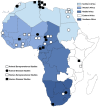Epidemiology of Coxiella burnetii infection in Africa: a OneHealth systematic review
- PMID: 24722554
- PMCID: PMC3983093
- DOI: 10.1371/journal.pntd.0002787
Epidemiology of Coxiella burnetii infection in Africa: a OneHealth systematic review
Abstract
Background: Q fever is a common cause of febrile illness and community-acquired pneumonia in resource-limited settings. Coxiella burnetii, the causative pathogen, is transmitted among varied host species, but the epidemiology of the organism in Africa is poorly understood. We conducted a systematic review of C. burnetii epidemiology in Africa from a "One Health" perspective to synthesize the published data and identify knowledge gaps.
Methods/principal findings: We searched nine databases to identify articles relevant to four key aspects of C. burnetii epidemiology in human and animal populations in Africa: infection prevalence; disease incidence; transmission risk factors; and infection control efforts. We identified 929 unique articles, 100 of which remained after full-text review. Of these, 41 articles describing 51 studies qualified for data extraction. Animal seroprevalence studies revealed infection by C. burnetii (≤13%) among cattle except for studies in Western and Middle Africa (18-55%). Small ruminant seroprevalence ranged from 11-33%. Human seroprevalence was <8% with the exception of studies among children and in Egypt (10-32%). Close contact with camels and rural residence were associated with increased seropositivity among humans. C. burnetii infection has been associated with livestock abortion. In human cohort studies, Q fever accounted for 2-9% of febrile illness hospitalizations and 1-3% of infective endocarditis cases. We found no studies of disease incidence estimates or disease control efforts.
Conclusions/significance: C. burnetii infection is detected in humans and in a wide range of animal species across Africa, but seroprevalence varies widely by species and location. Risk factors underlying this variability are poorly understood as is the role of C. burnetii in livestock abortion. Q fever consistently accounts for a notable proportion of undifferentiated human febrile illness and infective endocarditis in cohort studies, but incidence estimates are lacking. C. burnetii presents a real yet underappreciated threat to human and animal health throughout Africa.
Conflict of interest statement
The authors have declared that no competing interests exist.
Figures



References
-
- Tissot-Dupont H, Raoult D (2008) Q fever. Infect Dis Clin North Am 22: 505–514, ix. - PubMed
-
- Tissot-Dupont H, Vaillant V, Rey S, Raoult D (2007) Role of sex, age, previous valve lesion, and pregnancy in the clinical expression and outcome of Q fever after a large outbreak. Clin Infect Dis 44: 232–237. - PubMed
-
- van der Hoek W, Versteeg B, Meekelenkamp JC, Renders NH, Leenders AC, et al. (2011) Follow-up of 686 patients with acute Q fever and detection of chronic infection. Clin Infect Dis 52: 1431–1436. - PubMed
-
- Brouqui P, Dupont HT, Drancourt M, Berland Y, Etienne J, et al. (1993) Chronic Q fever. Ninety-two cases from France, including 27 cases without endocarditis. Arch Intern Med 153: 642–648. - PubMed
-
- Ayres JG, Flint N, Smith EG, Tunnicliffe WS, Fletcher TJ, et al. (1998) Post-infection fatigue syndrome following Q fever. QJM 91: 105–123. - PubMed
Publication types
MeSH terms
Grants and funding
- R01 TW009237/TW/FIC NIH HHS/United States
- G0902417/MRC_/Medical Research Council/United Kingdom
- WT_/Wellcome Trust/United Kingdom
- BB/H00935/1/BB_/Biotechnology and Biological Sciences Research Council/United Kingdom
- 096400/Z/11/Z/WT_/Wellcome Trust/United Kingdom
- BB/J010367/1/BB_/Biotechnology and Biological Sciences Research Council/United Kingdom
- R01TW009237/TW/FIC NIH HHS/United States
- R25 TW009343/TW/FIC NIH HHS/United States
- D43 PA-03-018/PHS HHS/United States
- BB/H009302/1/BB_/Biotechnology and Biological Sciences Research Council/United Kingdom
- R25TW009343/TW/FIC NIH HHS/United States
- U01 AI069484/AI/NIAID NIH HHS/United States
- R25 TW009337/TW/FIC NIH HHS/United States
LinkOut - more resources
Full Text Sources
Other Literature Sources

